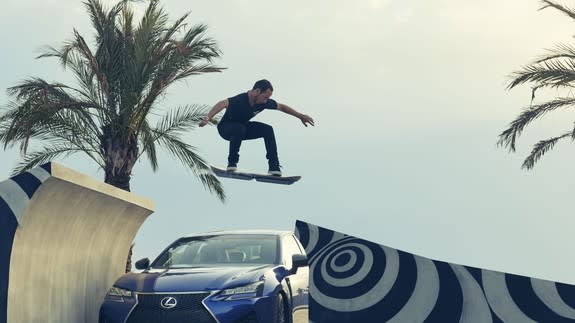3 companies that actually built real-life hoverboards

Movie fans and tech geeks alike have long shared a common dream: a chance to ride on Marty McFly's hoverboard, just like in Back to the Future Part II.
When the date portrayed in the movie, October 21, 2015, came and passed, though, the gadgets we most commonly thought of as hoverboards had two wheels and a propensity to explode, which definitely wasn't the future any of us were envisioning the first time we saw that iconic hoverboard chase sequence.
But levitating skateboards are already here. They might not anywhere near as commonplace as the Back to the Future universe foretold, but that doesn't mean the tech will never reach the streets (or at least a few inches above them) IRL.
SEE ALSO: This flying motorcycle is straight out of Star Wars
There are quite a few projects that have teased the potential for real, working hoverboards — and if we can have self-lacing Nike Mags, a Biff Tannen-esque figure in the White House, and World Series Champion Chicago Cubs, surely we can also have real, honest-to-God hoverboards... eventually.
Here are three companies that have made functional hoverboards, to varying levels of success. Through their efforts, we might someday finally fulfill those Marty McFly fantasies.
Hendo Hover
First up: Hendo Hover. The company behind the hoverboard, called Arx Pax, is mainly focused on harnessing electromagnetic energy through its Magnetic Field Architecture (MFA) system to create more sustainable, "floating" foundations for structures in the face of extreme weather. The Hendo board is a fun side project that serves as a proof of concept for the MFA system.
The Hendo design uses disc-shaped magnetic hover engines located on the bottom of the board, which depend on an opposing magnetic field found on a specialized surface below to provide lift. Unfortunately, you can't just ride it anywhere — but the system does actually allow riders to truly hover off the ground.
The boards first took on a rider in 2013, then launched on Kickstarter with a developer's kit the next year and showed up in its first public prototype form with none other than skateboarding legend (and hoverboard hoaxer) Tony Hawk onboard. Version 2.0 of the Hendo launched in 2015, which was the last we heard Arx Pax about board development as the company has focused on applying its MFA tech in other areas.
Omni Hoverboards
Omni's hoverboard design takes a different route to get its passenger in the air, using a system of propellors to take to the sky — it goes much higher than just hovering a few inches above the ground. It's closer to a drone than a skateboard, evoking less of a Marty McFly vibe and more like something the Green Goblin from Spider-Man might use to fly around.
Catalin Alexandru Duru, Omni's creator, developed his first prototype over the course of a year before setting out to break the Guinness World Record for the longest flight on a hoverboard back in May 2015. He only needed to fly 50 meters (about 165 feet) to break the previous mark — but he wound up zooming around for 275.9 meters (905 feet 2 inches) at heights of up to five meters (16 feet), obliterating the record in the process.
That mark was bested last year by a jet-powered rig, but Duru continues to hone his craft, taking it to France for flight demos and showing it off in a Hyatt ad to cap off 2016. The company aims to have a consumer-facing prototype ready by the end of this year, so keep an eye on the skies for one of these someday soon.
Lexus Hoverboard
Carmaker Lexus threw its hat into the hoverboard development ring, too, flexing its engineering muscles beyond the world of luxury vehicles. Starting in June 2015, the company released a set of teasers claiming it had created a real life, rideable hoverboard, piquing interest with footage that appeared to show the board floating in an otherwise normal skatepark.
When the final product was unveiled a few months later with a video showing pro skater Ross McGouran shredding up the skatepark in Barcelona, it really looked like Back to the Future's 2015 wasn't too far away — but there were some caveats.
Like Hendo, the Lexus board depended on a magnetic field to provide the hover power, so the skatepark was specially built for the ride. The smoke coming from the board wasn't just some cool add-on feature, either — in order to work, its components were cooled by liquid nitrogen to maintain a frigid temp of minus 197 degrees celsius.
Unfortunately for hoverboard enthusiasts, custom magnetized skateparks aren't too common, and Lexus made it clear that the board wasn't going to be released for consumers. For now, at least, the campaign was just a flight of marketing fancy to prove Lexus has the capability of creating something spectacular.
These three innovators have scratched the surface of hoverboard tech, and, given time and development, show that the experience is at least possible With future technological strides, what they began could eventually give everyone a shot at a real-life Marty McFly experience.
Ever wish you could fly?
Experience The Possible in virtual reality on the Within app.
Click here to download the Within app to watch The Possible.